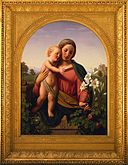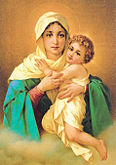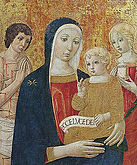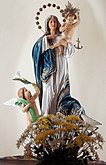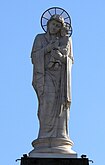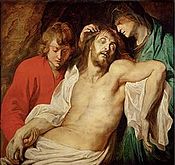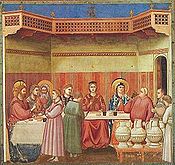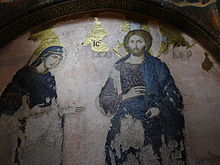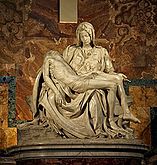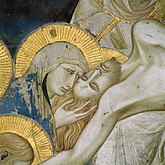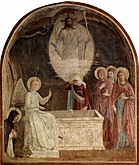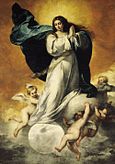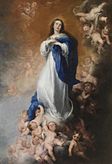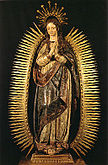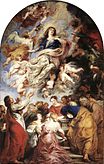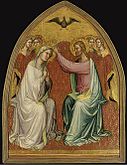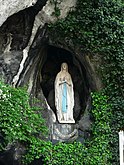Marian art in the Catholic Church
Marian art forms part of the fabric of Catholic Marian culture through their emotional impact on her veneration. Images such as
The body of teachings that constitute
| Part of a series on the |
| Mariology of the Catholic Church |
|---|
 |
|
Catholicism portal |
Blending of art, theology and spirituality
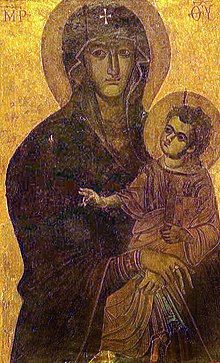
Art has been an integral element of Catholic identity since Late antiquity.[5] Medieval Catholicism cherished relics and pilgrimages to visit them were common. Churches and specific works of art were commissioned to honor the saints and the Virgin Mary has always been seen as the most powerful intercessor among all saints—her depictions being the subject of veneration among Catholics worldwide.[5]
Catholic Mariology does not simply consist of a set of theological writings, but also relies on the emotional impact of art, music and architecture.
In the 16th century,
An example of the interaction of Marian art, culture and churches is
Another example is

The use of Marian art by Catholics worldwide accompanies specific forms of
Historically, Marian art has not only impacted the image of Mary among Catholics, but that of Jesus. The early "
The spread of devotions to the Virgin of Mercy are another example of the blending of art and devotions among Catholics. In the 12th century Cîteaux Abbey in France used the motif of the protective mantle of the Virgin Mary which shielded the kneeling abbots and abbesses. In the 13th century Caesarius of Heisterbach was also aware of this motif, which eventually led to the iconography of the Virgin of Mercy and an increased focused on the concept of Marian protection.[31] By the beginning of the 16th century, depictions of the Virgin of Mercy were among the preferred artistic items in households in the Paris area.[32] In the 18th century Saint Alphonsus Liguori attributed his own recovery from near death to a statue of the Virgin of Mercy brought to his bedside.[33]
In his apostolic letter Archicoenobium Casinense in 1913,
Diversity of Marian art

Catholic Marian art has expressed a wide range of theological topics that relate to Mary, often in ways that are far from obvious, and whose meaning can only be recovered by detailed scholarly analysis. Entire books, academic theses or lengthy scholarly works have been written on various aspects of Marian art in general and on specific topics such as the Black Madonna, Our Lady of San Juan de los Lagos, Virgin of Mercy, Virgin of Ocotlán, or the Hortus conclusus and their doctrinal implications. [36][37][38][39][40]
Some of the leading Marian subjects include:
|
The tradition of Catholic Marian art has continued in the 21st century by artists such as Miguel Bejarano Moreno and Francisco Cárdenas Martínez.
Early veneration
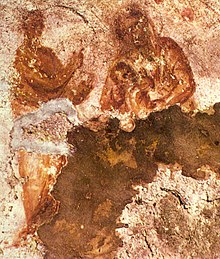
Early veneration of Mary is documented in the Catacombs of Rome. In the catacombs paintings show Mary with Jesus. More unusual and indicating the burial ground of Saint Peter, was the fact that excavations in the crypt of Saint Peter discovered a very early fresco of Mary together with Saint Peter.[41] The Roman Priscilla catacombs contain the known oldest Marian paintings, dating from the middle of the second century.[42] In one, Mary is shown with the infant Jesus on her lap. The Priscilla catacomb also includes the oldest known fresco of the Annunciation, dating to the 4th century.[43]
After the
The Virgin Mary has since become a major subject of Western Art. Masters such as
and others produced masterpieces with Marian themes.Mother of God
Mary's status as the
There was a great expansion of the
By the next century the iconic depiction of the Virgin enthroned carrying the infant Christ was established, as in the example from the only group of icons surviving from this period, at Saint Catherine's Monastery in Egypt. This type of depiction, with subtly changing differences of emphasis, has remained the mainstay of depictions of Mary to the present day. The image at Mount Sinai succeeds in combining two aspects of Mary described in the Magnificat, her humility and her exaltation above other humans.
At this period the
The earliest surviving image in a Western
Nativity of Jesus

The Nativity of Jesus has been a major subject of Christian art since the early 4th century. It has been depicted in many different media, both pictorial and sculptural. Pictorial forms include murals, panel paintings, manuscript illuminations, stained glass windows and oil paintings. The earliest representations of the Nativity itself are very simple, just showing the infant, tightly wrapped, lying near the ground in a trough or wicker basket.
A new form of the image, which from the rare early versions seems to have been formulated in 6th-century Palestine, was to set the essential form of Eastern Orthodox images down to the present day. The setting is now a cave – or rather the specific Cave of the Nativity in Bethlehem, already underneath the Church of the Nativity, and well-established as a place of pilgrimage, with the approval of the Church.
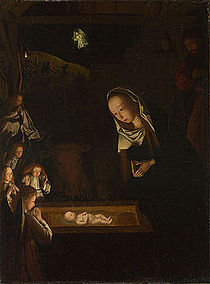
Western artists adopted many of the Byzantine iconographic elements, but preferred the scriptural stable to the cave, though Duccio's Byzantine-influenced Maestà version tries to have both. During the Gothic period, in the North earlier than in Italy, increasing closeness between mother and child develops, and Mary begins to hold her baby, or he looks over to her. Suckling is very unusual, but is sometimes shown.
The image in later medieval Northern Europe was often influenced by the vision of the Nativity of
From the 15th century onwards, the Adoration of the Magi increasingly became a more common depiction than the Nativity proper. From the 16th century plain Nativities with just the Holy Family, become a clear minority, although Caravaggio led a return to a more realistic treatment of the Adoration of the Shepherds.
The perpetual character of Mary's virginity, namely that she was a virgin all her life and not only at her
Madonna
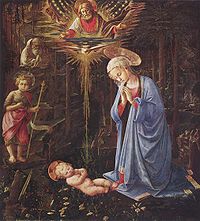
The depiction of the
In the Romanesque period free-standing statues, typically about half life-size, of the enthroned Madonna and Child were an original Western development, since monumental sculpture was forbidden by Orthodoxy. The Golden Madonna of Essen of c. 980 is one of the earliest of these, made of gold applied to a wooden core, and still the subject of considerable local veneration, as is the 12th century Virgin of Montserrat in Catalonia, a more developed treatment.
With the growth of monumental panel painting in Italy during the 12th and 13th centuries, this type was frequently painted at the image of the Madonna gains prominence outside of Rome, especially throughout Tuscany. While members of the mendicant orders of the Franciscan and Dominican Orders are some of the first to commission panels representing this subject matter, such works quickly became popular in monasteries, parish churches, and later homes. Some images of the Madonna were paid for by lay organizations called confraternities, who met to sing praises of the Virgin in chapels found within the newly reconstructed, spacious churches that were sometimes dedicated to her.
Some key Madonnas

A number of Madonna paintings and statues have gathered a following as important religious icons and noteworthy works of art in various regions of the world.
Some Madonnas are known by a general name and concept rendered or depicted by various artists. For instance,
Some Madonnas become the subject of widespread devotion, and the Marian shrines dedicated to them attract millions of pilgrims per year. An example is
Latin America
There is a rich tradition of building statues of the Madonna in South America, a sampling of which is shown in the galleries section of this article. The South American tradition of Marian art dates back to the 16th century, with the
- Our Lady of San Juan de los Lagos is located in the small town of San Juan de los Lagos in Mexico. It is the second most visited pilgrimage shrine in Mexico, after Our Lady of Guadalupe.
- The Virgin of Ocotlán is a statue of the Virgin Mary in Ocotlán, Tlaxcala, Mexico.
- Our Lady of Navigators is a highly venerated Madonna in Brazil. The devotion started by the 15th century Portuguese navigators, praying for a safe return to their homes and then spread in Brazil.
Images of, and devotions to, Madonnas such as Our Lady of San Juan de los Lagos have spread from Mexico to the United States.[53][54]
Italy and Spain
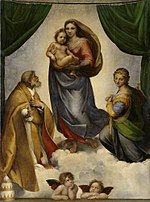
- The Madonna of humility by Domenico di Bartolo, 1433, is considered one of the most innovative devotional images from the early Renaissance.[35]
- Raphael's Sistine Madonna. The painting, originally commissioned for the church of San Sisto, Piacenza, is now at the Gemäldegalerie Alte Meister in Dresden (Germany). It is considered a key example of high Renaissance art.
- Church of the Gesu in Rome is a historic icon and the patron saint of the Jesuits
- The Madonna statue at the altar of Milan Cathedral is an outstanding example of Baroque Marian art
- Dolorosa Madonna in Seville, Spain is a key example of a sorrowful Madonna
- James the Greater.
- The Santa María de Montserrat monastery in Spain is a highly venerated statue and the patron saint of Catalonia.
Central and Northern Europe
- The Black Madonna of Częstochowa is Poland's holiest relic, and one of the country's national symbols.
- Dutch painter Throne of Wisdom, with Jesus sitting on her lap.
- Michelangelo's statue of the Virgin Mary and a standing Jesus known as the Madonna of Bruges at the Church of Our Lady, Bruges, Belgium shares some similarities with his Pietà which was completed sometime earlier.
- The 1898
Mary in the Life of Christ
Scenes of Mary and Jesus together fall into two main groups: those with an infant Jesus, and those from the last period of his life. After the episodes of the Nativity, there are a number of further narrative scenes of Mary and the infant Jesus together which are often depicted: the

Mary is then usually absent from scenes of the period of Christ's life between his
The main scenes above, showing incidents celebrated as
Perpetual virginity
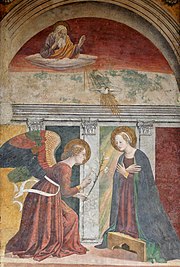
The
This dogma is often represented in Catholic art in terms of the
Frescos depicting this scene have appeared in Catholic Marian churches for centuries and it has been a topic addressed by many artists in multiple media, ranging from stained glass to mosaic, to relief, to sculpture to oil painting.[64] The oldest fresco of the annunciation is a 4th-century depiction in the Catacomb of Priscilla in Rome.[65] In most (but not all) Catholic, and indeed Western, depictions Gabriel is shown on the left, while in the Eastern Church he is more often depicted on the right.[66]
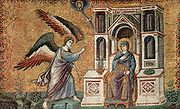
It has been one of the most frequent subjects of Christian art particularly during the
The natural composition of the scene, consisting of two figures facing each other, also made it suitable for decorated arches above doorways.
Immaculate Conception

Given that up to the 13th century a series of saints including Bernard of Clairvaux, Bonaventure, Thomas Aquinas, and the Dominicans in general had either opposed or questioned this doctrine, Catholic art on the subject mostly dates to periods after the 15th century and is absent from Renaissance art. But with support from popular opinion, the Franciscans and theologians such as Duns Scotus, the popularity of the doctrine increased and a feast-day for it was promoted.

Pope Pius V, the Dominican Pope who in 1570 established the Tridentine Mass, included the feast (but without the adjective "Immaculate") in the Tridentine calendar, but suppressed the existing special Mass for the feast, directing that the Mass for the Nativity of Mary (with the word "Nativity" replaced by "Conception") be used instead.[68] Part of that earlier Mass was revived in the Mass that Pope Pius IX ordered to be used on the feast and that is still in use.[69]
In the 16th century there was a widespread intellectual fashion for emblems in both religious and secular contexts. These consisted of a visual representation of the symbol (pictura) and usually a Latin motto; frequently an explanatory epigram was added. Emblem books were very popular.[70]
Drawing on the emblem tradition,
, flowers often associated with Mary.The
Depiction of the Immaculate Conception
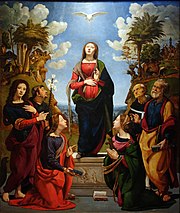
Many artists in the 15th century faced the problem of how to depict an abstract idea such as the Immaculate Conception, and the problem was not fully solved for 150 years.
Since a key Scriptural text pointed to in support of the doctrine was "

The definitive iconography for the Immaculate Conception, drawing on the emblem tradition, seems to have been established by the master and then father-in-law of Diego Velázquez, the painter and theorist Francisco Pacheco (1564–1644), to whom the Inquisition in Seville also contracted the approval of new images. He described his iconography in his Art of Painting (Arte de la Pintura, published posthumously in 1649):
"The version that I follow is the one that is closest to the holy revelation of the Evangelist and approved by the Catholic Church on the authority of the sacred and holy interpreters... In this loveliest of mysteries Our Lady should be painted as a beautiful young girl, 12 or 13 years old, in the flower of her youth... And thus she is praised by the Husband: tota pulchra es amica mea, a text that is always written in this painting. She should be painted wearing a white tunic and a blue mantle... She is surrounded by the sun, an oval sun of white and ochre, which sweetly blends into the sky. Rays of light emanate from her head, around which is a ring of twelve stars. An imperial crown adorns her head, without, however, hiding the stars. Under her feet is the moon. Although it is a solid globe, I take the liberty of making it transparent so that the landscape shows through."[72][73]
Assumption of Mary

The Catholic doctrine of the
An early supporter of the Assumption was Saint John of Damascus (676–794), a Doctor of the Church who is often called the Doctor of the Assumption.[76] Saint John was not only interested in the Assumption, but also supported the use of holy images in response to the edict by the Byzantine Emperor Leo III, banning the worship or exhibition of holy images.[77] He wrote: "On this day the sacred and life-filled ark of the living God, she who conceived her Creator in her womb, rests in the Temple of the Lord that is not made with hands. David, her ancestor, leaps, and with him the angels lead the dance."
The Eastern Church held the feast of the Assumption as early as the second half of the 6th century, and Pope Sergius I (687–701) ordered its observance in Rome.[78]
The Orthodox tradition is clear that Mary died normally, before being bodily assumed. The Orthodox term for the death is the
Meanwhile, depictions of the Assumption had been becoming more frequent during the late Middle Ages, with the Gothic Siennese school a particular source. By the 16th century they had become the norm, initially in Italy, and then elsewhere. They were sometimes combined with the Coronation of the Virgin, as the Trinity waited in the clouds. The subject was very suited to Baroque treatment.
Queen of Heaven
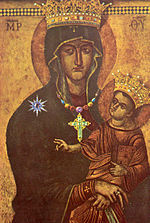
The Catholic teaching that Mary is far above all other creatures in dignity, and after

The feast of the
Yet, long before 1954 the Coronation of the Virgin had been the subject of a good number of artistic works. Some of these paintings built on the third phase of the Assumption of Mary in which following her Assumption, she is crowned as the Queen of Heaven.
Apparitions
Catholic devotion to Mary has at times been driven by
Although every year over five million pilgrims visit Lourdes and Guadalupe each, the volume of Catholic art to accompany this enthusiasm has been essentially restricted to popular images. Hence although apparitions have resulted in the construction of very large Marian churches at
Apparition-based art is at times considered miraculous by Catholics. Replicas of the distinctive blue and white statue of
Distinguishing characteristics
The Catholic approach to Marian art is quite distinct from the way other Christians (such as the Protestant and the
Unlike the majority of the Protestants, the Eastern Orthodox Church venerates Marian images, but in a different manner and with a different emphasis from the Catholic tradition. While statues of the Virgin Mary abound in Catholic churches, there are specific prohibitions against all three-dimensional representations (of Mary or any other any saints) within the Orthodox Church, for they are regarded as remnants of pagan idolatry. Hence the Orthodox only produce and venerate two-dimensional images.[90][91][92][93]
Catholic Marian images are almost entirely devotional depictions and do not have an official standing within liturgy, but Eastern icons are an inherent part of Orthodox liturgy. In fact, there is a three way, carefully coordinated interplay of prayers, icons and hymns to Mary within Orthodox liturgy, at times with specific feasts that relate to the Theotokos icons and the Akathists.[90][93][94]
While there is a tradition for the best known Western artists from
Apart from stylistic issues, significant doctrinal differences separate Catholic Marian art from other Christian approaches. Three examples are the depictions that involve the
Galleries of Marian art
Annunciation
- Perpetual virginity
-
Annunciation by Mariotto Albertinelli, 15th century
-
Annunciation by Murillo, 1655
-
Philippe de Champaigne, 1644
-
Annunciation by Pietro Perugino, 1489
-
Rubens Annunciation 1628 Antwerp
-
Botticelli, 1490
-
Francesco Albani Annunciation The Hermitage
-
Mikhail Nesterov, Russia, 19th century
Birth of Jesus
- Birth of Christ
-
Adoration of the Magi, ivory, 15th century
-
Marten de Vos, 1577
-
Lorenzo Lotto, 1523
-
Pietro Perugino, 15th century
-
Pedro Berruguete, 15th century
-
Giorgione, c1507
-
Gregorio Fernández, 1614
-
Gauguin, 1896
Adoration of the shepherds
- Adoration of the shepherds
-
Caravaggio, 16th century
-
Bronzino, 16th century
-
Guido Reni, 1630–1642
-
Gaudenzio Ferrari c1533
-
Gerard van Honthorst, 1622
-
Domenico Ghirlandaio, 1485
-
Giorgione, 1510
Adoration of the Magi
- Adoration of the Magi
-
Rembrandt, 1632
-
Rubens, 1634
-
Botticelli, 1475
-
Murillo, 17th century
-
Gentile da Fabriano, 1423
-
Jacopo da Ponte, 1563–1564
-
Diego Velázquez, 1619
Madonna paintings
Pre 15th century
- Pre 15th century
-
Virgin, 6th century, St. Catherine Monastery
-
Vatopedi, Mount Athos, Greece, pre-870
-
Russian Theotokos icon, 10th century
-
Madonna, Cimabue 13th century
-
Madonna and Angels, Duccio, 1282
-
Madonna by Giotto, c1300
-
Giacomo di Mino, 1342
-
Naddo Ceccarelli, 1347
15-16th century
- 15-16th century
-
Taddeo di Bartolo 1400–1405
-
Throne of Wisdom, 1430
-
Madonna and Child, Filippo Lippi 1440–1445
-
Madonna, with God the Father in evidence, Filippo Lippi, 1459
-
Benois Madonna, Leonardo da Vinci, 1475
-
Botticelli, 1481
-
Madonna and five angels,Botticelli, c1485–1490
-
The Glorification of the Virgin, Geertgen tot Sint Jans, c. 1490–1495
-
Madonna del Granduca, Raphael, 1505
-
Tempi Madonna, Raphael, 1508
-
Titian, 1520
Post 16th century
- Post 16th century
-
Madonna and Child by Sassoferrato, 17th century
-
Our Lady of Rokitno, Poland, 1671
-
Dolorosa, Murillo, 1665
-
Madonna, Pompeo Batoni, 1742
-
Virgin of the Host,Dominique Ingres, 1852
-
Franz Ittenbach, 1855
-
Bouguereau, 1900
Madonna frescos
- Pre 15th century
-
Fontignano. Pietro Perugino, 1522
Madonna statues
- Madonna statues
-
Assumption statue, Attard, Malta
-
Our Lady of Navigators, Porto Alegre, Brazil
-
Our Lady of Aparecida, patron saint of Brazil
-
Our Lady of Saúde, Portugal
-
Our Lady of Sorrows in Warfhuizen, dressed for October
-
Golden Madonna of Essen, Essen, Germany
-
Virgen de los Ángeles, Costa Rica
-
Assumption statue, Għaxaq, Malta, 1808
-
Baroque Madonna Altar at the Milan Cathedral
Mary in the Life of Christ
- Mary in the Life of Christ
-
Rubens, Lamentation 1614/1615
-
Marriage at Cana, Giotto.
-
Christ and Mary, mosaic,Chora Church, 16th century
-
Correggio, 1517–1518
-
Deposition of Christ, Regnault, 1789
-
Michelangelo's Pietà, 1498
-
Pietro Lorenzetti, Assisi Basilica, 1310–1329
-
Resurrection of Christ, Fra Angelico, 1437
Immaculate Conception
- Immaculate conception
-
Murillo Immaculate Conception, 1650
-
Murillo Immaculate Conception, 1678
-
Velázquez Immaculate Conception, 1618
-
di Cosimo Immaculate Conception, 1505
-
Zurbarán Immaculate Conception, 1630
-
Carlo Maratta, 1689
-
Statue, Porto Alegre, Brazil, 19th century
-
Gregorio Fernández, 17th century
Assumption into Heaven
- Assumption
-
Andrea Mantegna Dormition 1461
-
RubensAssumption, 1626
-
Titian Assumption, 1516
-
Mateo Cerezo Assumption, 1650
-
Guercino Assumption, 1655
-
Andrea del Sarto Assumption, 1526
-
RubensAssumption of the Virgin, 17th century
-
Charles Le Brun, 1835
Queen of Heaven
- Queen of Heaven
-
Martino di Bartolomeo, 1400
-
Crowning of the Virgin byRubens, 17th century
-
Velázquez, Crowning of the Virgin, 1645
-
Gregorio di Cecco Enthroned Madonna
-
Giacomo di Mino, 1340–1350
-
Raphael, 1502–1504
-
Pietro Perugino, 1504
-
Giulio Cesare Procaccini, 17th century
Apparitions
- Apparitions
-
The Vision ofFra Bartolommeoc. 1504
-
Virgin Mary by Caravaggio, 17th century
-
Statue of theSt. Simon, by Alfonso Balzico, Rome, 19th century
-
Apparition to St.Lodovico Carracci1594
-
Virgin of Guadalupeanonymous, 18th century
-
Statue of Our Lady of Lourdes, Lourdes, France
See also
- Catholic art
- Catholic Marian churches
- Marian devotions
- Hymns to Mary
- Madonna (art)
- Fountain of Life
- Theotokos
- Icon of the Hodegetria
Notes
- ISBN 978-0-9712981-9-4
- ^ ISBN 1-4051-2051-7p. 45
- ^ ISBN 0-7425-2284-9pp. 41–43
- ISBN 978-0-8245-1760-1
- ^ ISBN 0-8091-3750-Xpp. 96–98
- ISBN 978-0-89870-849-3
- ISBN 9783937406404
- ^ University of Dayton Marian Music https://udayton.edu/imri/mary/b/birth-of-mary-meditation-and-illustrations.php
- ISBN 978-0-312-19503-8
- ^ ISBN 0-8147-9591-9pp. 37–42
- ^ ISBN 1-933146-34-6p. 288
- ^ Catholic encyclopedia
- ISBN 0-87973-910-Xpp. 431–433
- ^ Vatican website: Pope John Paul II in the Philippines
- ISBN 0-313-30415-7p. 58
- ISBN 1-56518-250-2p. 129
- ISBN 0-8147-1630-Xp. 355
- ISBN 0-8223-4547-1pp. 278–280
- ISBN 90-04-12654-6p. 339
- ISBN 1-59276-441-Xp. 123
- ISBN 0-8147-9591-9p. 193
- ISBN 0-520-21326-2pp. 6–7
- ISBN 0-86554-373-9pp. 520–525
- ISBN 0-8028-3167-2pp. 113, 179
- ISBN 0-664-22117-3pp. 11–13
- ISBN 0-521-78291-0pp. 183–184
- ISBN 0-8146-3184-3pp. 86–87
- ISBN 0-8369-2378-2pp. 110–112
- ISBN 0-7425-5157-1pp. 3–5
- ISBN 0-7614-1475-4p. 109
- ISBN 978-1-57918-355-4pp. 725–737
- ISBN 0-674-53180-9p. 145
- ^ Saint Alphonsus Liguori by Saint Alfonso Maria de' Liguori, Richard Paul Blakeney 1852 p. 20
- ^ Acta Apostolicae Sedis 5, 1913, pp. 113–117
- ^ ISBN 0-7546-0689-9 p. 15 [1]
- ^ Roten S.M., Johann G., "Birth of Mary: Meditation and Illustration", International Marian Research Institute, University of Dayton
- ^ The Madonna della Misericordia in the Italian Renaissance by Carol McCall Rand, 1987, Thesis, Virginia Commonwealth University
- ^ Virgen de San Juan Shrine, by Bonnie Robertson, 1980 ASIN: B0021ZHECE
- ^ Luis Nava Rodríguez, 1975 Historia de Nuestra Senora de Ocotlan Tlaxcala: Editoria de periodicos "La Prensa", MLCS 98/02238
- ISBN 90-6450-349-4
- ^ M Guarducci Maria nelle epigrafi paleocristiane di Roma 1963, 248
- ^ I Daoust, Marie dans les catacombes, in "Esprit et Vie", n. 91, 1983.
- ISBN 1568545576page 29
- ISBN 0520074122Univ California Press page 303
- ISBN 8882652173pages 33-35
- ^ ISBN 097129819Xpages 37-40
- ISBN 0967637120pages 9-12
- ISBN 0877790442page 408
- ^ Infancy Gospel of James, chapter 20 Archived 2008-06-11 at the Wayback Machine
- ISBN 1-57958-009-2p. 904
- ISBN 1576072231pages 308-309
- ISBN 0826334598
- ISBN 0-7425-3184-8p. 78
- ISBN 0-8135-3285-Xp. 74
- ^ Schoenstatt website "Father's Shepherds". Schoenstatt Movement. August 14, 2009. Archived from the original on 2009-10-10. Retrieved 2008-07-18.
- ^ Research on Luigi Crosio Archived 2012-06-29 at archive.today
- ^ University of Dayton Archived 2012-05-09 at the Wayback Machine
- ^ Marian Dogmas at University of Dayton http://campus.udayton.edu/mary/mariandogmas.html
- ^ Divine Liturgy of St John Chrysostom, Coptic Liturgy of St Basil, Liturgy of St Cyril Archived 2012-05-09 at WebCite, Liturgy of St James Archived 15 June 2008 at the Wayback Machine, Understanding the Orthodox Liturgy, etc.
- ^ L. Gambero, Mary and the Fathers of the Church trans. T. Buffer (San Francisco: Ignatius, 1991), p. 35.
- ISBN 0-8160-5023-6.
- ISBN 0-313-29329-5p. 99
- ^ Christian iconography: a study of its origins by André Grabar 1968 Taylor & Francis p. 130
- ISBN 0-7148-4447-0
- ISBN 1-56854-557-6p. 29
- ISBN 0-19-866165-7p. 24
- ISBN 0-313-29329-5p. 16
- ^ Paul Cavendish, "The Tridentine Mass"
- ^ Marion A. Habig, "Land of Mary Immaculate"
- ^ Emblems for Immaculate Conception "Birth of Mary: Meditation and Illustrations". All About Mary. International Marian Research Institute, University of Dayton. Archived from the original on 2008-12-11. Retrieved 2008-12-05.
- ^ The whole text Archived 2011-05-29 at the Wayback Machine
- ISBN 90-429-0955-2p. 676
- ISBN 0-19-514557-7p. 98
- Original Sin, which is chiefly Death. http://www.newadvent.org/fathers/3819.htmNicea II Session 6 Decree
- ^ Nicaea II Definition, "without blemish"
- ^
Christopher Rengers, The 33 Doctors Of The Church, Tan Books & Publishers, 200, ISBN 0-89555-440-2
- ^ Mary H. Allies, St. John Damascene on Holy Images, Followed by Three Sermons on the Assumption London, 1899.
- ^ University of Dayton http://campus.udayton.edu/mary/resources/maryassump1.html
- ^ Dictionary of Mary, Catholic Book Publishing Co., New York, 1985
- ^ Ad Caeli Reginam 40
- ^ ISBN 0-8160-4134-2.
- ISBN 0-87973-454-X
- ISBN 90-232-1457-9p. 174
- ISBN 0-8263-1620-4p. 68
- ISBN 0-7546-6789-8p. 38
- ^ a b Encyclical Ad Caeli Reginam on the Vatican website
- ISBN 0-415-92472-3pp. 171–173
- ISBN 0-9712981-9-Xp. 61
- ISBN 0-19-280328-Xpp. 102–106
- ^ ISBN 0-202-36298-1pp. 4–9
- ISBN 963-9241-61-Xpp. 45–48
- ^ Encyclopedia of Catholicism by Frank K. Flinn, J. Gordon Melton 2007 ISBN pp. 244–245
- ^ ISBN 0-9745618-0-0pp. 177–178
- ISBN 0-252-07551-Xpp. 56–57
- ISBN 0-8192-1910-X, 2002 p. 48
- ISBN 0-8160-6141-6pp. 33–34
- ISBN 978-1-882972-06-7pp. 64–70
- ISBN 0-86012-257-3p. 147
References
- D'Ancona, Mirella Levi (1977). Garden of the Renaissance: Botanical Symbolism in Italian Painting. Firenze: Casa Editrice Leo S.Olschki. ISBN 9788822217899.
- D'Ancona, Mirella Levi (1957). The iconography of the Immaculate Conception in the Middle Ages and early Renaissance. College Art Association of America. ASIN B0007DEREA.
- Beckwith, John (1969). Early Medieval Art. Thames and Hudson. ISBN 0-500-20019-X.
- Arnold Hauser, Mannerism: The Crisis of the Renaissance and the Origins of Modern Art, Cambridge: Harvard University Press, 1965, ISBN 0-674-54815-9
- Levey, Michael (1961). From Giotto to Cézanne. Thames and Hudson,. ISBN 0-500-20024-6.
- Myers, Bernard (1965, 1985). Landmarks of Western Art. Hamlyn. ISBN 0-600-35840-2.
- Rice, David Talbot (1997). Art of the Byzantine Era. Thames and Hudson. ISBN 0-500-20004-1.
Further reading
- Dupre, Judith. Full of Grace: Encountering Mary in Faith, Art, and Life, 2010 ISBN 1-4000-6585-2
- Gustafson, Fred. The Black Madonna, 2008 ISBN 3-85630-720-6
External links
- Christian Iconography from Augusta State University – see under Virgin Mary, after alphabet of saints
- Birth of Mary in Art, All About Mary The University of Dayton's Marian Library/International Marian Research Institute (IMRI) is the world's largest repository of books, artwork and artifacts devoted to Mary, the mother of Christ, and a pontifical center of research and scholarship with a vast presence in cyberspace.

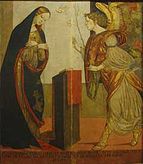




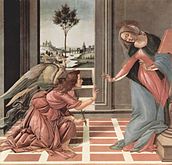



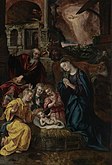
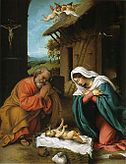



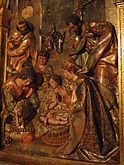

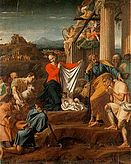

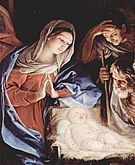
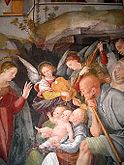
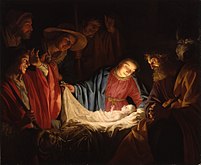




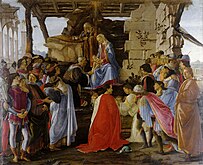

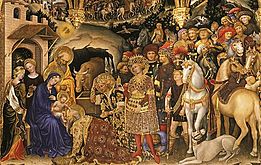
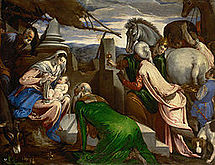

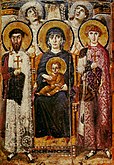
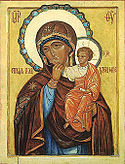
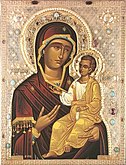

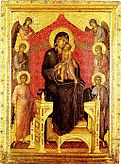
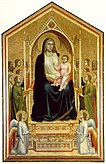

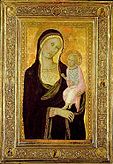
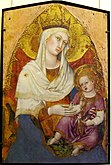
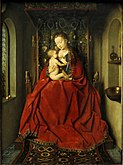


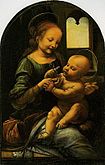



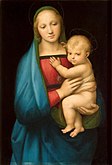
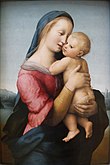


![Our Lady of Rokitno [pl], Poland, 1671](http://upload.wikimedia.org/wikipedia/commons/thumb/2/2f/Matka-Boza_Rokitno.jpg/136px-Matka-Boza_Rokitno.jpg)



